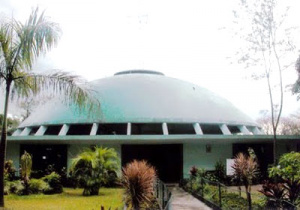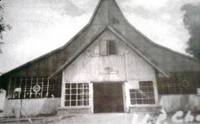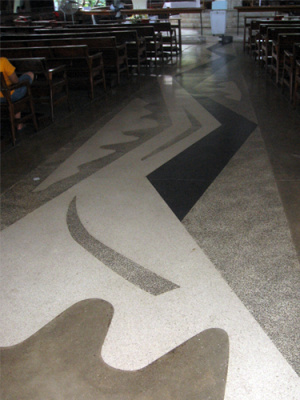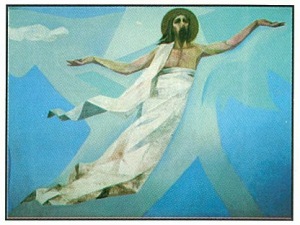Parish of the Holy Sacrifice
Places of Worship
Art Studies 2 THU-4
Prof. Roberto G. Paulino
Avecilla, Minerva Bianca Uy
Salonga, Gabrielle Joy
The Parish of the Holy Sacrifice
A Masterpiece of Four National Artists

Location
J. P. Laurel cor. Apacible St. Agoncillo, University of the Philippines Diliman Quezon City
Boundaries
From the junction of Don Mariano marcos Ave., and Juan Luna St., East, thru Juan Luna St., Southward thru the Eastern Limits of East: From the Eastern limits of Pook Dagohoy, Southward thru Katipunan Ave. Eastward thru Montalban St. Southward thru the Eastern limits of UP High School and Up Integrated School.

Sawali Chapel
During the early years on the campus,three religions, namely Catholics, Protestants and Aglipayans shared the Sawali chapel which was used by the American troops. But due to the differences in the beliefs and with the number of members for each religion growing, it has been decided that respective places of worship must be built. It was during the term of President Vidal Arceo Tan when the 2 religious groups were allowed to have separate sanctuaries.

Concept of Fr. John P. Delaney
The concept of Fr. Delaney was centered on the Holy Sacrifice of the Mass. For him, the Mass is everything in our lives as believers of God. He wanted the parishioners to be close with the priest every time a Mass is being celebrated and thus having a concept of an altar at the center of a round Church. He wanted the Church to be open to everyone anytime they want to pray, to hear Mass or to talk to God thus having no doors so that parishioners can only see entrances encouraging them to go in any time. Fr. Delaney commissioned the help of four artists who eventually became nNational Artists to help him materialize his concept of the Church.
Structure Design
Leandro V. Locsin
National Artist in Architecture, 1992
-
Structure Design1
-
Structure Design2
Originally,Leandro Locsin designed the Church for the Ossorio Family in Negros but when they left the country the plan was scrapped. When Fr. Delaney relayed to Leandro Locsin his concept of the Church, Leandro Locsin adapted his previous design of the Church and thus coming up with the final design of the circular Church with a saucer-shaped roof, the pews situated around the altar in the middle of the Church and with 14 entrances but no doors.
dimension : ____________
Sculptures
Napoleon V. Abueva
National Artist in Sculpture, 1976
-
Wooden Cross
-
Altar
The Cross symbolizes the 2 figures of Christ - Christ the Victim ( Crucified Christ) and Christ the Priest ( Risen Christ). The marble altar has the Sermon on the Mount on one side and a scene of a priest standing with the parishioners and a nun teaching small children.
Floor Mural
Arturo R. Luz
National Artist in Visual Arts, 1997

Arturo Luz designed the floor mural called River of Life which signifies that life is similar to a river flowing from God who is the source of all life.
Murals
Vicente S. Manansala
National Artist in Painting, 1981

Vicente Manansala painted the 14 Stations of the Cross with an additional of a final station which is the Resurrection of Christ
Chapel of Adoration of the Blessed Sacrament
There is a small chapel located beside the Church, with shiny parquet flooring, burnished wooden walls with bamboo accents and ambient interior lighting. Displayed behind glass in one wall rests the Blessed Sacrament and beside it is the Tabernacle containing the Communion hosts.
Gardens Around the Church
There are seven gardens surrounding the Church:
1.Garden of Communion: features the bust of Fr. Delaney and it depicts the unity of time, action, spirit and natures four elements of earth, fire, wind and water.
2.Garden of Love and Friendship: embodies the evolution from friendship to love to courtship to marriage. It has four monoliths, the first two upright rocks is for friendship, which means that friends doesn't need physical contact to remain as friends. The second set of two monoliths are leaning toward each other signifying romantic love. Then the last monolith standing alone can have four meanings - when two persons become one in marriage, when one of the two dies and leave the other behind, when one remains single and the most important is that one goes through life alone
3.Garden of the Family: features five rocks which represent the 2 nature of family, the natural biological family and the ideal spiritual family. The pools of water represents the beginning of life
4.Garden of Religions: features three rocks close to one another which represent the three major religions – Christianity, Islam and Judaism. This symbolizes that even though each has respective beliefs, they can still co-exist with nature
5.Garden of Justice and Peace: features the tree nursery of the Church. It will also feature a bronze monument of the three martyr-priests – Fr. Mariano Gomez, Jose Burgos and Jacinto Zamora as a tribute. These are to be sculpted by Tito Sanchez
6.Garden of Mother and Healing: features the Grotto of Our Lady of Fatima, which stands for motherland and nurturance.
7.Garden of Eternal Life: features three rock monoliths. These represent the stages in life from the dead , to slowly rising and to finally the resurrected one.
-
Garden of Communion
-
Garden of Love and Friendship
-
Garden of Family
-
Garden of Religions
-
Garden of Mother and Healing
-
Our Lady of Fatima
-
Garden of Eternal Life
Mortuary Chapels
There are 2 mortuary chapels which are not only exclusive to the members of the UP Diliman Community but as well as those living nearby.
References
Directory
Telephone numbers: (632) 926-1592 or (632) 926-9496













